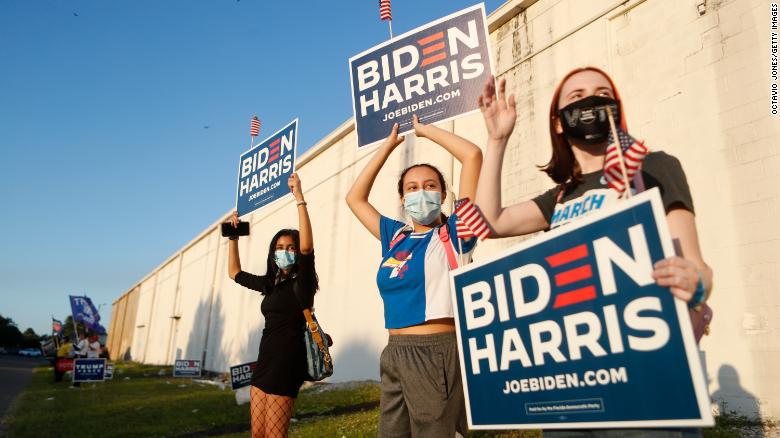
(CNN) – It was hard to escape the headlines this past week about President Joe Biden and young voters.
“Democrats ring alarm bells over young voters”
“Biden’s challenge: getting his mojo back with younger voters”
“Younger voters are turning on Biden more than any other age group: poll”
Such headlines are not surprising when a president is struggling in the polls. People always want to find an explanation for what is going wrong.
The debate over young voters is where we start our statistical journey this week, and why all may not be what it appears at first glance.
Biden has a young voter problem, but Democrats do not
If you look at any polling trendline over the past year, it’s been troubling for Biden. His approval rating has dropped by more than 10 points. A recent Gallup report, which I highlighted last week, points to his falling popularity with young Americans as the problem.
Biden’s approval rating with Americans 18-29 years old is just 38 percent in aggregated Gallup data since September. From January 2021 to June 2021, it was 61 percent — about the same percentage of the vote he earned among voters under 30 in the 2020 election.
Biden’s popularity among young Americans went from being higher than any other age group to being lower than almost any other age group.
Sometimes, however, approval ratings don’t tell the whole story. In this case, these approval ratings might suggest that the Democrats will lose among young voters in the midterm elections. A look at the generic ballot, on other hand, indicates that would be wrong.
Take a look at data from the Pew Research Center, which polled both the generic congressional ballot and Biden’s approval rating in March. (The generic ballot usually asks respondents some form of the following question: “If the elections for Congress were held today, would you vote for the Democratic or Republican Party?”)
Biden’s approval rating among voters under 30 was 39 percent. This, of course, is very similar to Gallup’s reading of this age group.
When voters under 30 were asked who they would vote for in their congressional district, Democrats held a 48 percent to 29 percent advantage over the Republicans. That 48 percent vote share and 19-point lead were better from Democrats than responses from any other age group.
This poll is no outlier. A CNN/SSRS poll from January and February put Biden’s approval rating at 43 percent among voters under 30. Democrats’ lead on the generic congressional ballot was 15 points. Averaging CNN and Pew data puts Democrats’ lead at 17 points among voters under 30.
(Averaging other polling, from Fox News and Quinnipiac University, backs this up, as they had Democrats ahead by 12 to 13 points in the larger age group of 18-34 year olds. A slightly smaller advantage when including some older voters is expected.)
Democrats won the national House vote among voters under 30 by, depending on the source, somewhere between 22 (Catalist) and 26 (the network exit polls) points in 2020. That averages out to a 24-point margin.
The fact that the current Democratic lead among young voters is seven points less than their 2020 margin with this group makes a lot of sense. The political environment has shifted against the party, as the generic congressional ballot shows Democrats doing worse among all voters by a similar margin — about five to six points.
If nothing else, it’s a sign that, even if Biden isn’t liked by most young Americans, Republicans haven’t come anywhere close to sealing the deal with them.
I should further note that Biden has had previous issues with young voters, only to recover later. His advantage with this group during the early parts of the 2020 general election campaign was significantly smaller than Hillary Clinton’s in the 2016 election. By the end of the campaign, he outperformed her.
That’s not to say all is good for Democrats among young voters ahead of the midterm elections.
Just 10 percent of voters under 30 said they were extremely enthusiastic about casting a ballot this fall in CNN’s most recent poll on the topic. A higher percentage of voters overall (24 percent) indicated they were extremely enthusiastic.
That’s nothing out of the ordinary, though. Younger voters were less enthusiastic, by about 10 points, at this point in 2018 as well, and turnout with this group is always lower than that of voters of other ages.
This doesn’t mean that young voter enthusiasm won’t drop more or that Biden’s unpopularity won’t affect them. It’s just that for now, it hasn’t. Democrats have larger fish to fry, with the national political environment turning against them.
Don’t count Biden out for 2024
Anyone who has read or watched me on TV over the last six months knows that I’m extremely pessimistic about Democrats’ chances of holding on to the US House in 2022. Part of the reason is Biden’s unpopularity and a lack of historical precedent for the type of recovery he would need in his approval rating to not be a drag on his party.
But that doesn’t mean Biden’s approval rating won’t recover eventually. In fact, I would make the statistical argument that Biden’s 2024 stock is undervalued in the betting markets, with him getting roughly equal odds of winning with Ron DeSantis (between 20 and 25 percent).
No one, except for Biden himself, knows how serious he is about running for another term. He is already the oldest president. Yet, there hasn’t been an elected president who has chosen not to run for a second term in more than 140 years. The reporting out there suggests Biden is far more likely to run if former President Donald Trump runs, and almost all signs point to Trump running.
At a minimum, Biden would be a heavy favorite to win his party’s nomination were he to run.
His approval rating among Democrats has been hovering at or above 80 percent, according to data from Gallup. Historically, incumbents with an approval rating of 80 percent or higher within their own party by the time of the presidential primaries have not faced serious challenges.
Sitting presidents who either lost a primary or dropped out of running for another term all had approval ratings among their party’s voters of below 70 percent. (George H.W. Bush, who didn’t lose a primary but was challenged by Pat Buchanan in 1992, had an approval rating in the low 70s.)
As for the general election, keep in mind that most presidents who make it to November have won reelection. They have won about two-thirds of the time. That general percentage holds whether you look at elections over the last 40 years or the last 100 years.
Trump nearly pulled it off, despite consistently having low approval ratings and facing a global pandemic and a middling economy in his reelection year.
The fact is there is no significant correlation between approval ratings at this point in a president’s term and whether he gets reelected. Nor is there any significant correlation between how the president’s party does in a midterm and whether he gets reelected. And although voters are upset over the state of the economy now, there is, if anything, a negative correlation between early economic performance and a president’s reelection chances.
The bottom line is I have no clue who is going to win 2024, though betting on an incumbent president is usually a pretty decent bet.




